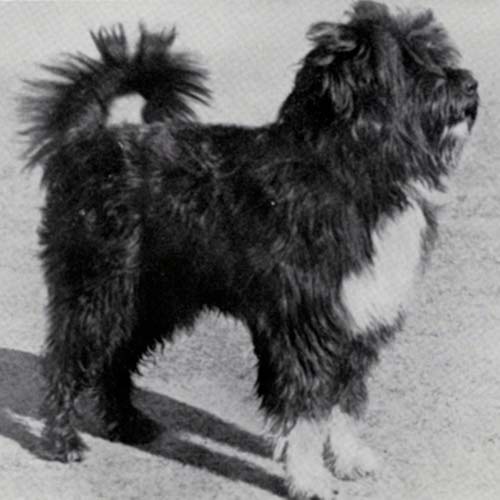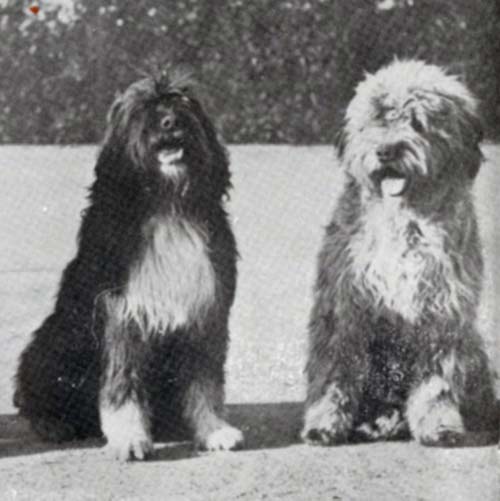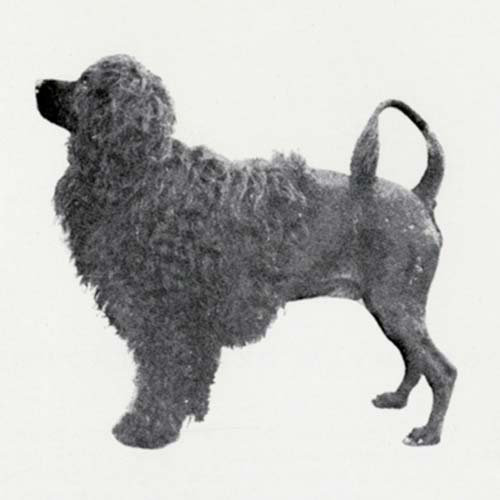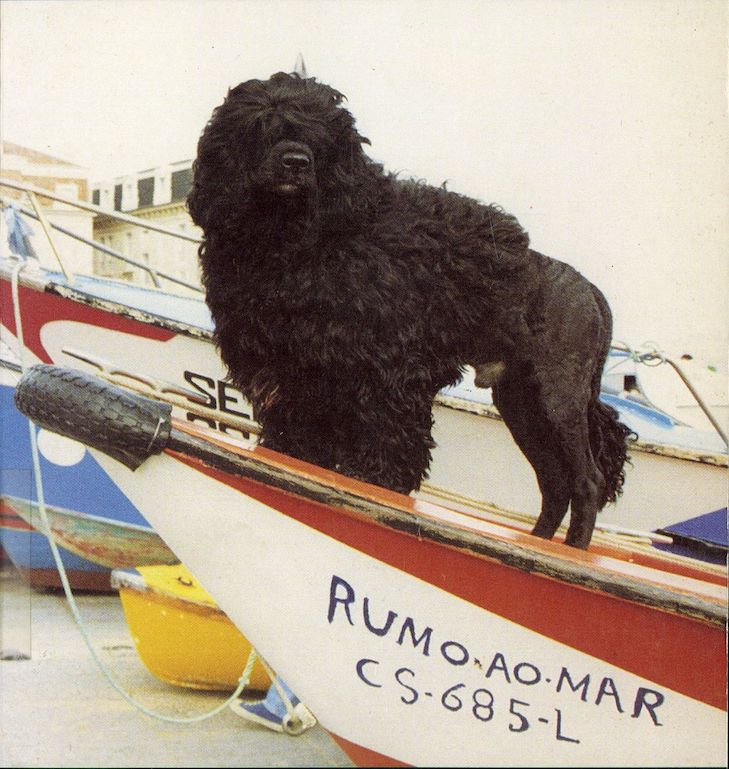Few individuals can blame their unemployment on a baseball player’s hitting prowess. But one breed of curly-coated dogs can make that claim — the Portuguese Water Dog.
Back in 2000, the San Francisco Giants needed individuals who could retrieve the long foul balls and home runs that batters would send beyond Pacific Bell Stadium’s right-field fence and into McCovey Cove, an inlet of the San Francisco Bay. Comedian Don Novello thought that Portuguese Water Dogs would be perfect for the job, and he worked with a local animal rescue, Pets in Need, to station the dogs in McCovey Cove during some Giants games. The dogs, dubbed the Baseball Aquatic Retrieval Korps — BARK for short — were a big hit (pun not intended) among Giants fans, not to mention dog lovers.
Then along came Barry Bonds. The Giants left fielder’s ever-rising home-run total prompted an ever-rising number of human boaters to enter McCovey Cove in hopes of scooping a Bonds- clobbered baseball out of the drink. “After a couple of years, there was great concern for the dogs’ safety in McCovey Cove with all of the boats, especially during the peak Barry Bonds home run era,” recalls Tracy Pore, community outreach specialist from San Francisco. “So the BARK program was discontinued.”
But although the BARK Portuguese Water Dogs no longer patrol McCovey Cove, their forced retirement in no way diminishes the charm and diligence of this breed. In fact, the Portuguese Water Dog’s history is rooted in a strong work ethic.

Dogs of the Fisherman
Several theories exist as to the PWD’s origins. One traces the breed’s beginnings back to 200 B.C. and centers on the Iberian Peninsula, which is located in the extreme southwestern corner of Europe and is today divided into four countries: Gibraltar, Andorra, Spain, and Portugal. The peninsula endured many invasions by external forces. The invaders included the Romans, the Visigoths, and the Moors, each of whom brought their own special working dogs.
“The Romans had their ‘canis leo ’ or Lion Dog, the Visigoths had their ‘canis pescator’ or Fishing Dog, and the Moors had their Great Water Dog,” explains Maryanne Murray, former president of the Portuguese Water Dog Club of America (PWDCA), current chair of the club’s breed standard committee, and co-chair of the club’s Heart Committee. “Over hundreds of years, these dogs interbred and eventually started to breed true to a particular type. This type-a sturdy, longhaired, willing water worker was identified by the Portuguese fishermen as being a valuable asset to their work, and the dogs became known as the ‘fisherman’s dog.’ Over the course of time, they became the Portuguese Water Dog.”

Another theory places the PWD’s beginnings back even further, to 700 B.C.E., near the border between Russia and China. Here the relatively isolated people raised dogs to herd cattle, sheep, camels, or horses. The dogs developed into a clear type that looked much like today’s PWD. Nomadic Berber warriors were said to have captured some of these dogs, who then traveled with their new masters across Asia to North Africa. Their descendants, the Moors, then brought the dogs to Iberia in the eighth century.
Still another theory posits that the Asian dogs traveled with another nomadic tribe, the Goths, who came from what is now Germany. One offshoot of that tribe, the Ostrogoths, headed west; their dogs became what is now known as the Poodle. Another offshoot, the Visigoths, headed south, fought the Romans, and then made their way to the Iberian Peninsula, where the dogs eventually became today’s PWDs.
In any case, once the dogs reached Iberia, they became adept at all kinds of tasks related to fishing and water work. They herded fish into nets, retrieved broken nets or lost tackle, and acted as aquatic couriers from boat to shore or between boats.

Flash forward to 1934, when a wealthy Portuguese shipping magnate named Vasco Bensaude became enchanted with the breed after seeing two PWDs at a dog show in Lisbon. “With a goal in mind of preserving the breed, he started an extensive search for more dogs and fortunately found a few working on the fishing boats in the Algarve region of Portugal,” says Murray, who lives in Green Lane, Pennsylvania. “He was able to acquire a male and female during that first search.
On a subsequent trip, Bensaude discovered another female and a magnificent male who worked daily on the boats. He desperately wanted this male and after much negotiating with the fisherman owner, he acquired Leao, the dog who became the foundation for [Bensaude’s| Algarbiorum Kennel and the ideal model for the breed standard.”
According to Murray, Bensaude bred PWDs for nearly 30 years but rarely sold any of the dogs he bred. Instead, he gave them to friends and associates. He died in 1957, and a year later his widow gave the 14 remaining dogs in the kennel to a trusted friend.
At about that time, Mr. and Mrs. Arthur Harrington, of Renssalear. New York, received a pair of PWDs from England in exchange for a pair of Affenpinschers. The Harringtons bred the PWD pair and a litter resulted, but the strain eventually died out. However, American interest in the breed resurged 10 years later, when Mr. and Mrs. Herbert Miller, of New Canaan, Connecticut, imported a female from a Portuguese woman who’d inherited Bensaude’s kennels. A year later, the Millers imported a male.
“Their first litter, born on June 17, 1971, at the Millers’ home in Nantucket, was the first litter of PWDs of Portuguese breeding stock in the U.S.A.,” says Murray. A year later, on August 13, 1972, the Millers hosted a gathering of 16 people to establish the Portuguese Water Dog Club of America. The Millers’ litter of the previous year was the first recorded by the new club. In 1984, the breed became eligible for full AKC registration in the Working Group. Murray reports that today the United States has more PWDs than any other country. In 2006, the AKC registered 1,454 individual PWDs and 310 litters-a long way from that initial litter of 35 years prior.
In 2009, the PWD got a worldwide stage when President Obama welcomed Bo into their family. Four years later, they welcomed another PWD, Sunny, into the White house.
In 2020, Portuguese Water Dogs ranked 49th most popular out of 195 breeds.

Spirited, Social, Soggy
Today’s PWD is a rugged, robust dog, equipped with webbed feet and a nonshed ding, waterproof coat-the better to do all that water work in. Murray considers Leao, the first PWD acquired by Vasco Bensaude, to be the quintessential representative of the breed. “He was spirited, self-willed, and brave, and strong enough and mentally tough enough to do a full day’s work in and out of the water,” Murray says. “A real Portuguese Water Dog is spirited, exceptionally intelligent, powerful, and a bundle of predetermined energy.”
To past PWDCA president Steven Dostie, another early PWD epitomizes the ideal breed representative. That dog was Ch. Charlie de Alavalade, better known as Charlie Brown. Mrs. Miller imported the dog from Portugal, and in 1984 Charlie Brown became the first PWDCA breed champion. His many accomplishments include four BOB wins at Westminster. “He was a true ambassador of the breed and the first Portuguese Water Dog that I met,” recalls Dostie, who lives in Bowdoinham. Maine. “His lively and confident personality attracted me to the breed.” Mrs. Miller shares Dostie’s enthusiasm about Charlie Brown. “He was the best ambassador for the breed we’ve ever had,” she says. “And his downline offspring continue to pay tribute to his great characteristics and unique joie de vivre.”
PWD enthusiasts find creative ways to maintain their breed’s working heritage. Employing the dogs to fetch errant baseballs like the BARK dogs of San Francisco is one example; in addition, PWD’s can be found performing in agility, obedience, tracking, and rally.

